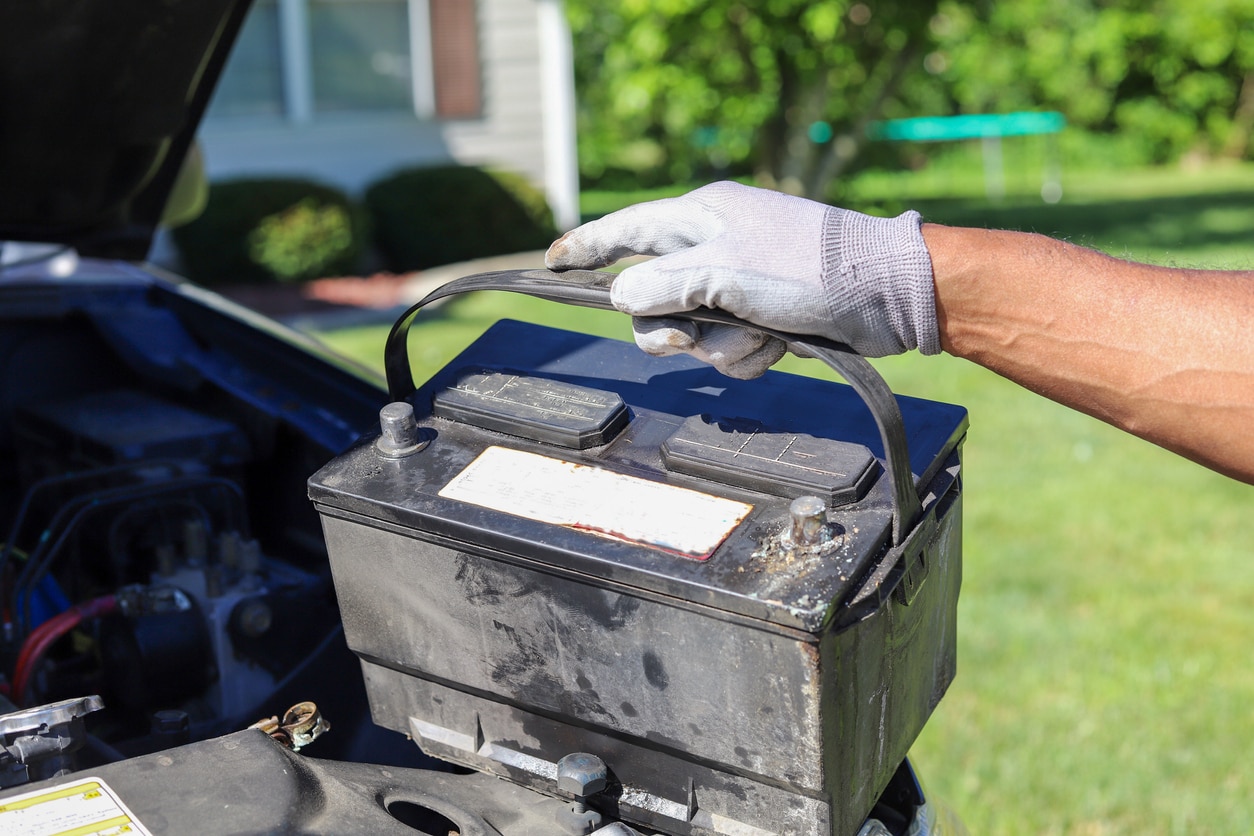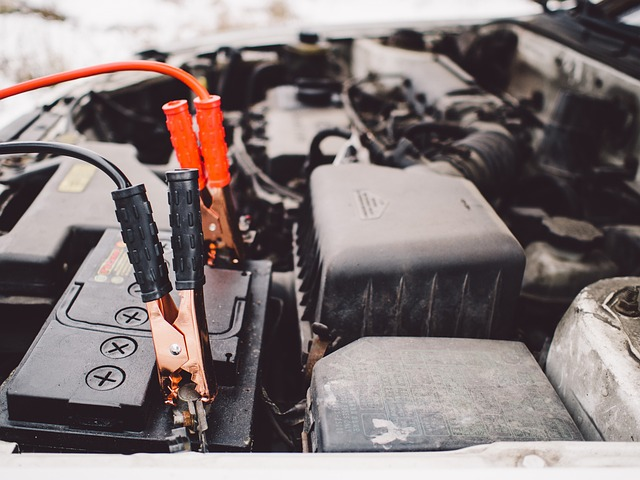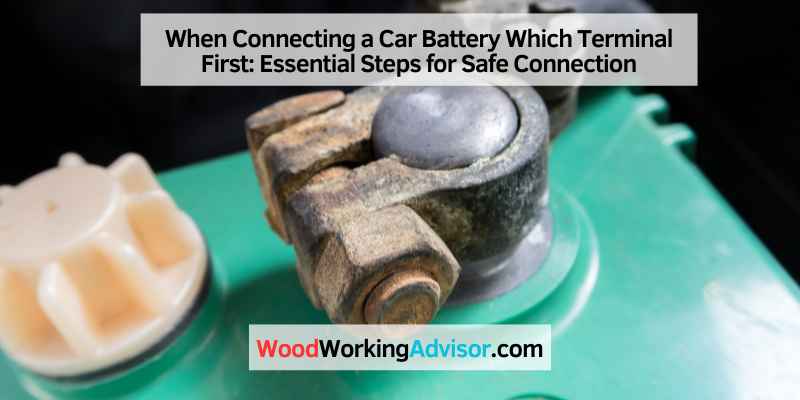When connecting a car battery, always connect the positive terminal first, followed by the negative terminal. This order prevents potential risks of short circuits and electrical shock during the process.
When installing a new battery or replacing an old one in a vehicle, it’s crucial to understand the proper sequence to ensure the safety of the car and the individual performing the task. By following the correct steps and taking necessary precautions, you can successfully connect the battery without any complications.
Now, let’s delve deeper into the importance of connecting the terminals in the correct order and how it contributes to maintaining a smooth and safe operation of the vehicle’s electrical system.

Credit: www.firestonecompleteautocare.com
Importance Of Proper Connection
When connecting a car battery, it is crucial to follow the correct procedure to ensure safety and prevent damage. Taking the time to understand which terminal to connect first can save you from potential accidents or expensive repairs.
Ensuring Safety
Properly connecting the battery terminals in the correct order is essential for maintaining safety. The car battery contains a substantial amount of energy, and any mishandling can lead to dangerous situations. By following the correct procedure, you minimize the risk of sparks, fires, or even explosions from occurring.
Here’s a step-by-step guide to ensure safety when connecting your car battery:
- Before beginning the process, make sure the car engine is turned off and the key is removed from the ignition to avoid any accidental electrical contact.
- Identify the positive and negative terminals on the battery. The positive terminal is usually marked with a plus sign (+) and is typically red, while the negative terminal is marked with a minus sign (-) and is often black.
- Connect the positive terminal first by attaching the corresponding cable clamp securely. Ensure that it makes good contact with the terminal.
- Next, connect the negative terminal by attaching the cable clamp to the negative terminal. Again, ensure it is securely fastened.
By following these steps, you eliminate the risk of electrical mishaps and keep yourself and your vehicle safe.
Preventing Damage
Properly connecting the car battery terminals in the correct sequence not only ensures safety but also prevents potential damage to your vehicle’s electrical system.
If you mistakenly connect the negative terminal first, there is a chance of creating a short circuit when connecting the positive terminal. This short circuit can cause a surge of electrical current, damaging sensitive electronic components in your car.
Connecting the positive terminal first prevents the risk of a short circuit and potential damage to your car’s electrical system.
Additionally, when disconnecting the battery, it is vital to follow the opposite order: disconnect the negative terminal first, followed by the positive terminal. This ensures a safe and damage-free process.
Remember that even a minor mistake when handling your car battery can result in expensive repairs or even the need for a replacement. Avoid unnecessary costs by always connecting the battery terminals in the appropriate order.
Essential Tools
When connecting a car battery, always remember to attach the positive terminal first before the negative terminal. This order helps prevent electrical issues and ensures safe and proper connection of the battery. Following this step-by-step process is crucial for maintaining the battery’s integrity and the vehicle’s overall functionality.
Safety Gloves
Adjustable Wrench
When connecting a car battery, safety should always come first. Essential tools are required to ensure the job is done correctly and safely.
Safety Gloves
- Protect hands from acids and other potentially harmful substances
- Prevent accidental electric shock
Adjustable Wrench
- Used to loosen and tighten battery terminals
- Ensures a secure and proper connection
Steps For Safe Connection
When connecting a car battery, always attach the positive terminal first, followed by the negative terminal. This sequence reduces the risk of sparking or short circuits. Remember to double-check the connections before starting the engine.
Turning Off Ignition
Before connecting a car battery, turn off the ignition to avoid any electrical mishaps.
Identifying Positive And Negative Terminals
Locate the positive (+) and negative (-) terminals on the battery.
- Positive terminal: usually marked with a “+” sign
- Negative terminal: often bigger and marked with a “-“ sign
Connecting The Battery
When it comes to connecting a car battery, it is important to follow the correct procedure to ensure safety and prevent any damage to the vehicle or yourself. The first step is to remove the old battery, if necessary, making sure to disconnect the negative terminal first. Once you have a new battery ready, you can proceed with connecting it to your car. In this section, we will go through the process of attaching the positive terminal first, followed by attaching the negative terminal second.
Attaching Positive Terminal First
Before connecting the battery, it is crucial to identify which terminal is positive and which is negative. The positive terminal is usually marked with a “+”, while the negative terminal is marked with a “-“. To attach the positive terminal, you should:
- Locate the positive terminal on the battery. It is usually red in color and may be labeled as “POS” or “+”.
- Take the positive cable, which is usually red or has a red band, and align it with the positive terminal.
- Gently place the cable connector over the positive terminal and ensure it is securely connected.
- Tighten the nut or bolt on the cable connector using a wrench or pliers, being careful not to overtighten.
By attaching the positive terminal first, you reduce the risk of accidentally short-circuiting the battery or causing any sparks.
Attaching Negative Terminal Second
Once the positive terminal is securely attached, you can proceed with attaching the negative terminal. To do this:
- Locate the negative terminal on the battery. It is usually black in color and may be labeled as “NEG” or “-“.
- Take the negative cable, which is usually black or has a black band, and align it with the negative terminal.
- Gently place the cable connector over the negative terminal and ensure it is securely connected.
- Tighten the nut or bolt on the cable connector using a wrench or pliers, being careful not to overtighten.
By attaching the negative terminal second, you reduce the risk of accidentally causing any sparks or short-circuits while connecting the battery.
Remember, it is important to handle the battery terminals carefully and avoid any contact between the positive and negative terminals to prevent electrical shock or damage. Following these steps will ensure a safe and successful connection of your car battery.
Post-connection Checks
When connecting a car battery, it’s crucial to prioritize safety and follow the correct procedure. Always connect the positive terminal first, followed by the negative terminal, to avoid potential hazards and ensure a smooth post-connection check. This approach minimizes the risk of electrical interference and damage to the vehicle’s components.
Tightness Of Connections
“` Once the car battery is connected, it’s crucial to perform a series of post-connection checks to ensure everything is in place. Checking the tightness of connections is essential to prevent any potential hazards. Use a wrench to ensure that the terminal clamps are secured snugly to the battery posts.
Secure Mounting Of Battery
“` To avoid any movement or vibrations that can lead to damage, it’s vital to check the secure mounting of the battery. Ensure that the battery is tightly secured in its mount, and there are no loose components that could cause it to shift while the vehicle is in motion. Verify that the hold-down hardware is in place and tightened properly. These post-connection checks are integral in ensuring the proper functioning and safety of the vehicle’s electrical system. Always pay close attention to these details when dealing with car battery connections.

Credit: www.stonemountainvw.com
Restarting The Vehicle
To safely restart your vehicle when connecting a car battery, always start by connecting the positive terminal followed by the negative terminal. This ensures a smooth and reliable restart without risking any electrical damage.
Safety Precautions
When connecting a car battery, safety precautions should be the top priority. Be sure to wear safety gloves and goggles to protect yourself from any potential hazards. Additionally, ensure the vehicle is in park and the ignition is turned off to avoid any electrical mishaps.
Observing Initial Operation
Once the car battery has been connected, it is crucial to observe the initial operation of the vehicle. Check for any signs of unusual behavior, such as flickering lights or unusual sounds. It is important to remain vigilant and attentive during this phase to address any possible issues promptly.
Common Mistakes To Avoid
Switching Positive And Negative
When connecting a car battery, one of the most common mistakes that people make is switching the positive and negative terminals. This can have serious consequences and can even result in damage to your vehicle’s electrical system. It is important to always double-check which terminal is positive and which is negative before making any connections.
Switching the positive and negative terminals can lead to a reversed polarity, which means that the electrical current will flow in the wrong direction. This can cause various issues, such as damaging the battery, blowing fuses, or even damaging sensitive electronic components in your car.
To avoid this mistake, you can follow a simple rule: the positive terminal is usually marked with a plus sign (+) or the letters “POS” or “P,” while the negative terminal is often marked with a minus sign (-) or the letters “NEG” or “N.” Remember to always check the markings or the manual of your specific car model to be absolutely sure.
Leaving Tools On Battery
Another common mistake to avoid when connecting a car battery is leaving tools on the battery while making the connections. This can lead to accidental short circuits or sparks, which can be dangerous and even cause injury.
Always make sure to remove any tools or metallic objects from the area around the battery before starting the connection process. It is also important to wear protective gloves and goggles to prevent any injuries from sparks or accidental contact with the battery terminals.
A simple tip to help you remember this step is to create a safe and clean workspace before starting any battery-related work on your car. This means removing any unnecessary clutter or debris, ensuring a clear and safe area to work in.
By following these simple guidelines, you can avoid common mistakes when connecting a car battery and ensure the safety of yourself and your vehicle’s electrical system.
Credit: www.quora.com
Conclusion
To sum up, when connecting a car battery, it is crucial to always remember to connect the positive terminal first, followed by the negative terminal. This sequence ensures safety precautions and avoids potential electrical hazards. By adhering to this simple rule, you protect yourself, your vehicle, and maintain the overall longevity of your battery.
Stay safe on the road!


